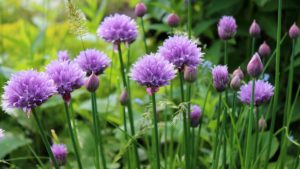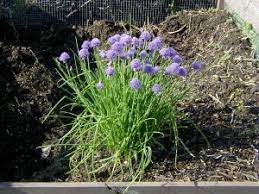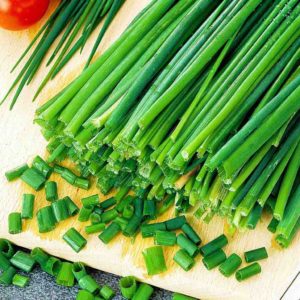 While most of my garden is still dormant from the winter months, there’s one abundant beauty that is already unfurling its blooms… Chives! Chives are a favorite springtime herbs. This hardy perennial is one of the first plants to grow in the spring and harvests can begin weeks before some herbs have even woken up. Too often chives are dismissed as just a garnish, something to sprinkle on your sour cream and baked potato. But chives have many health benefits! They check off so many boxes:
While most of my garden is still dormant from the winter months, there’s one abundant beauty that is already unfurling its blooms… Chives! Chives are a favorite springtime herbs. This hardy perennial is one of the first plants to grow in the spring and harvests can begin weeks before some herbs have even woken up. Too often chives are dismissed as just a garnish, something to sprinkle on your sour cream and baked potato. But chives have many health benefits! They check off so many boxes:
- Strong medicine
- Delicious as food
- Easy to grow (or find)
What are Chives?
Chives are a perennial plant related to garlic and onions. Their botanical name is Allium schoenoprasum. Chives are the only allium that is native to North America, Europe, and Asia. Humans have been enjoying chives for thousands of years. While we typically eat the bulbs of garlic and onions, with chives we eat the leaves and flowers.
Chives as Food and Medicine
Similar to their garlic and onion cousins, chives are pungent and spicy. These flavor characteristics tells us that these are fantastic herbs for addressing stuck or stagnant digestion. They spice up digestion and warm things up! You don’t have to have poor digestion to benefit from chives. You can simply enjoy them as a way to maintain healthy digestion. Their spicy and pungent nature makes them a great addition when eating heavier foods (yes, like that sour cream and potato). They have many of the same constituents as garlic and onion, like allicin, sulphur and phenolic compounds, flavonoids, saponins, and steroidal glycosides. Plus, chives may help keep your food safe! They’ve been shown to inhibit Escherichia coli in a food model. And chive leaves are exceptionally high in antioxidants! Even higher than garlic and onions. Adding just a bit of fresh chives to your meal is a fantastic way to modulate inflammation and promote health.
How to Grow (or Find) Chives
 Chives are fun and easy to grow! As a perennial they return year after year. They are also easy to grow in a container. Visit your local plant nursery to see if you can buy a plant start there. Or ask your gardening friends if they have some chives to spare. Chives readily spread and are easy to dig up and share. Existing plants can also be divided. Plant your chives in rich soil that drains well. Chives aren’t a fussy plant. They do need to be watered occasionally (depending on where you live) but otherwise can be left to do their thing.
Chives are fun and easy to grow! As a perennial they return year after year. They are also easy to grow in a container. Visit your local plant nursery to see if you can buy a plant start there. Or ask your gardening friends if they have some chives to spare. Chives readily spread and are easy to dig up and share. Existing plants can also be divided. Plant your chives in rich soil that drains well. Chives aren’t a fussy plant. They do need to be watered occasionally (depending on where you live) but otherwise can be left to do their thing.
Another convienent place to plant them is just outside a backdoor. Having chives super close so you can spontaneously harvest some leaves to add to your meals is a convienent idea. You can harvest chive leaves using sharp scissors. Harvesting chives encourages new growth, so don’t be afraid to harvest! Bees love the chive blossoms, which contain lots of nectar, so leave flowers for them. However, once the flowers begin to fade it’s a good idea to cut them at the bottom of their stalk to keep the chives producing well.
How to Work with Chives
 Chives are best when fresh. Growing your own is ideal: that way you have them readily available, and you can use them just after cutting. You can also find chives at farmers markets and in the fresh herb section of grocery stores. When buying chives be sure to use them up quickly. They don’t last. Here’s some of the ways I love to use chive leaves— Abundantly sprinkled on practically any meal from our veggie and egg breakfast to a topping on our salmon or even pizza. You can have chives in sandwiches or add them to pesto. If it’s a savory meal, you can probably add chives to it! Chive flowers are beautiful and delicious! You can break up the flower and spread it on salads or use it as a pretty garnish for practically every meal.
Chives are best when fresh. Growing your own is ideal: that way you have them readily available, and you can use them just after cutting. You can also find chives at farmers markets and in the fresh herb section of grocery stores. When buying chives be sure to use them up quickly. They don’t last. Here’s some of the ways I love to use chive leaves— Abundantly sprinkled on practically any meal from our veggie and egg breakfast to a topping on our salmon or even pizza. You can have chives in sandwiches or add them to pesto. If it’s a savory meal, you can probably add chives to it! Chive flowers are beautiful and delicious! You can break up the flower and spread it on salads or use it as a pretty garnish for practically every meal.
